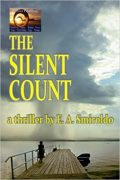The Making of The Silent Count, or How I Learned to Stop Worrying and Love the Bomb
The Making of The Silent Count, or How I Learned to Stop Worrying and Love the Bomb
 It is a truth universally acknowledged by the how-to-write-a-novel industrial complex that a thriller in want of a good plot must be in possession of a ticking time bomb.
It is a truth universally acknowledged by the how-to-write-a-novel industrial complex that a thriller in want of a good plot must be in possession of a ticking time bomb.
I learned this the hard way while trying to write a novel after inspiration struck, anvil-on-Wile E. Coyote-style. I was obsessed with an idea that suggested a thriller, but clueless about how to turn it into a cohesive story. Moreover, I loved Jane Austen, not Tom Clancy, and majored in nuclear engineering in college, the antithesis of creative writing.
Enter the plot twist: those engineering classes ultimately inspired my literary vision. The book that changed my life, shook me to the core, rocked my world, was Introduction to Nuclear Engineering by the late John R. Lamarsh.
I’ll explain. During my undergraduate years, nuclear engineering was the least popular major in America (thanks, Chernobyl!), so much so that this particular textbook, released in 1983, wasn’t updated until 2001. Unlike subsequent Lamarsh editions, the first page of my 1983 volume said the following:
“…there are a number of ways in which nuclear explosives may be used for peaceful purposes…It should even be possible to alter unfavorable weather patterns in many parts of the world by removing mountain ranges which obstruct the flow of air.” [Emphasis mine.]
I was stunned. Why weren’t my classmates or professors talking about this? Why hadn’t anyone alerted the media? And most importantly, why had no one written an epic science fiction novel premised on these bonkers facts?
This was all I could think of for a long time. Geoengineering scenarios featuring nuclear weapons would come to me in the middle of the night, at work, in conversations with people clearly on verge of faking their own deaths rather than listen to me blather on. And when global warming stories made the news, I wondered how these ideas might intersect.
Not in real life, of course – in fiction! (I was obsessed, not insane.) Jonathan Swift’s essay A Modest Proposal reminded me that through satire, an outlandish notion could point out harsh truths about the world. Those ideas and harsh truths lived rent-free like dirty squatters in my head.
Alas, ideas do not a novel make. Indeed, three hundred pages of random assertions call to mind the Unabomber.
I needed to learn the nuts and bolts of novel-writing before I lost my momentum. Here’s where the aforementioned how-to-write-a-novel guides came in handy. On Writing by Stephen King, The Artist’s Way by Julia Cameron, Writing the Breakout Novel by Donald Maass, Save the Cat Writes a Novel by, I dunno, Fluffy? I bought them all. Common elements emerged for theme, plot, character arcs, conflict. Place the inciting incident and hook at the start, they said, followed by rising action leading to the climax in the middle; resolve the story at the end. Kill your darlings, stay away from adverbs, don’t head hop…
And, for thrillers, always include a ticking time bomb.
The bomb could be metaphorical as long as it intensified tension, stakes, and sense of danger. My time bomb was actual since atomic weapons were key components of the storyline. The basic plot unfolded in a series of questions my head:
What if climate change got so bad the government decided to try the old “eliminate the mountain range to change the weather patterns” trick? What if a young nuclear engineer who did her dissertation on this very subject got the chance to implement her hypothetical planet-saving idea? What if government overreach, lying to the public, and countless other devastating, unintended consequences ensued? It’s up to the young engineer to fight the power before they drop the bomb and turn her solution into the end of the world as we know it.
I liked this line-of-questioning approach, but something was missing. The next inquiry zeroed in on what that was: Who cares?
Who cares, indeed. A novel is about far more than an engaging plot. There’s a reason why we’re still talking about indelible characters of classical literature all these years later, like Elizabeth Bennet and Emma Woodhouse, Jane Austen’s most beloved protagonists. “Lizzie” with her inability to get past her initial prejudices toward Mr. Darcy, Emma with her constant meddling in other people’s lives. Readers have rooted for both women to overcome their flaws to find true love and happiness for more than two hundred years.
Clearly, the best novels are about more than just ticking time bombs. They’re about real human beings that readers can care about and relate to, with their foibles and frailties, overcoming obstacles to achieve their dreams. The Silent Count’s main character, Dara Bouldin, isn’t just trying to save the planet and outrun the villain. She figures out what she truly wants from life and love, acknowledges her own shortcomings, learns to ask for help, and realizes she might need to be on a different path altogether.
It took time, but I finished writing The Silent Count, which Solstice Publishing released not long ago. Since it came out, Hydrogen Fuel News called it “a satire for our times;” it won first place in the political thriller category of The BookFest’s 2022 novel competition; and, best of all, readers tell me they’ve fallen in love with my characters. Now I’m planning the sequel, complete with a real or symbolic time bomb. I’ve accepted that a thriller needs this, but know that the real story will always be about the people.
—
E.A. Smiroldo is a nuclear engineer, musician, and writer who lives in the Washington, DC-area. Her debut novel, the climate fiction thriller The Silent Count, was released on Solstice Publishing. She’s won several writing and songwriting awards, optioned a screenplay treatment with X-ray Media, and most recently served as an official beta reader for the anthology No More Fairy Tales: Stories to Save our Planet (https://habitatpress.com/no-more-fairy-tales/), which was distributed to the delegates of the United Nations Conference on Climate Change (COP27). Her website is EASmiroldo.com
THE SILENT COUNT
 Nuclear engineer Dara Bouldin’s life is a mess. She’s paying off her dad’s gambling debts, reeling from a broken engagement, and practically invisible at the energy research agency where she works. Meanwhile, her ex Jericho’s latest single is racing up the charts and her handsome new colleague Dmitri is friendly with everyone but her.
Nuclear engineer Dara Bouldin’s life is a mess. She’s paying off her dad’s gambling debts, reeling from a broken engagement, and practically invisible at the energy research agency where she works. Meanwhile, her ex Jericho’s latest single is racing up the charts and her handsome new colleague Dmitri is friendly with everyone but her.
BUY HERE
Category: How To and Tips



























